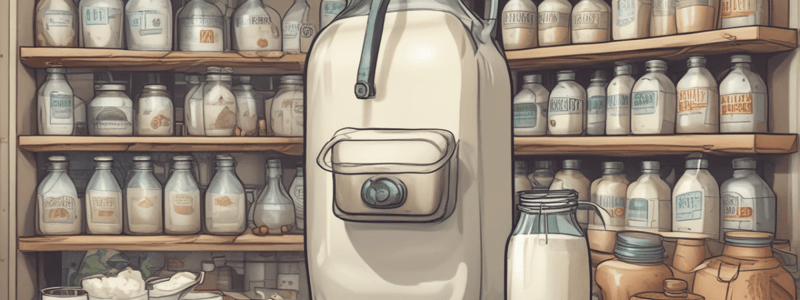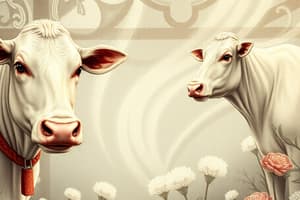Podcast
Questions and Answers
What is the main difference between unpasteurised and pasteurised milk?
What is the main difference between unpasteurised and pasteurised milk?
- The country of origin
- The breed of cow used
- The level of fat content
- The application of heat (correct)
What is the controversy surrounding raw milk?
What is the controversy surrounding raw milk?
- Its lower nutritional value compared to pasteurised milk
- Its high fat content
- The potential presence of harmful micro-organisms (correct)
- Its exclusive availability in organic stores
What is the advantage of raw milk over pasteurised milk in terms of bacterial growth?
What is the advantage of raw milk over pasteurised milk in terms of bacterial growth?
- Raw milk has a lower pH level
- Pathogens in raw milk face more competition before claiming victory (correct)
- Raw milk has a higher fat content
- Raw milk is more widely available
What is required for the production of safe raw milk?
What is required for the production of safe raw milk?
What is the situation with raw milk consumption in America?
What is the situation with raw milk consumption in America?
Why is it rare to find raw milk in many places?
Why is it rare to find raw milk in many places?
What is the situation with dairy product safety in Ireland and the UK?
What is the situation with dairy product safety in Ireland and the UK?
What is the legal status of selling raw milk in Ireland?
What is the legal status of selling raw milk in Ireland?
In which country is buying raw milk legal as long as it is bought directly from the dairy farm?
In which country is buying raw milk legal as long as it is bought directly from the dairy farm?
Who invented the process of pasteurisation?
Who invented the process of pasteurisation?
What is the minimum temperature required for pasteurisation of milk?
What is the minimum temperature required for pasteurisation of milk?
What is the main advantage of UHT pasteurisation?
What is the main advantage of UHT pasteurisation?
What happens to the protein structure of milk during UHT pasteurisation?
What happens to the protein structure of milk during UHT pasteurisation?
Why do researchers think raw milk may reduce the risk of eczema and hay fever in children?
Why do researchers think raw milk may reduce the risk of eczema and hay fever in children?
What happens to the fat globules during homogenisation?
What happens to the fat globules during homogenisation?
What is a characteristic of organic milk compared to conventionally produced milk?
What is a characteristic of organic milk compared to conventionally produced milk?
What is a benefit of unhomogenised milk?
What is a benefit of unhomogenised milk?
What is a drawback of homogenised milk compared to raw or pasteurised milk?
What is a drawback of homogenised milk compared to raw or pasteurised milk?
What is the characteristic of milk from cows that have fed on grass?
What is the characteristic of milk from cows that have fed on grass?
What is the fat content of full-fat milk?
What is the fat content of full-fat milk?
Which type of milk comes naturally homogenised?
Which type of milk comes naturally homogenised?
How much milk can a goat give in a day?
How much milk can a goat give in a day?
What can happen to milk if it is heated too intensely?
What can happen to milk if it is heated too intensely?
Why should milk be stored in reusable glass bottles?
Why should milk be stored in reusable glass bottles?
What is beestings also known as?
What is beestings also known as?
How many milkings are considered as colostrum?
How many milkings are considered as colostrum?
What is done to beestings to make it into curds?
What is done to beestings to make it into curds?
How can you serve beestings curds?
How can you serve beestings curds?
Flashcards are hidden until you start studying
Study Notes
Milk Types
- There are two main types of milk: unpasteurised (raw) milk and pasteurised milk
- Unpasteurised milk comes directly from the animal and has a richer flavor and mouthfeel compared to industrially processed milk
- Pasteurised milk has been heat treated to kill harmful micro-organisms
Unpasteurised Milk
- Raw milk must come from healthy animals from a TB-free and Brucellosis-free herd
- Raw milk has a shorter shelf life and is typically consumed fresh
- Some countries have laws regulating the sale of raw milk, such as in America where people can participate in "cow shares" to access raw milk
- Raw milk can be found in some artisan supermarkets, such as Eataly in Turin, Italy
Pasteurised Milk
- Pasteurisation was invented by Louis Pasteur in 1862 and involves heating milk to 63°C (145°F) for at least 30 minutes to kill micro-organisms
- Pasteurisation can be applied to many foods, but for milk, it involves heating to 63°C (145°F) for at least 30 minutes, 72°C (161°F) for 15 seconds, or 89°C (192°F) for 1 second
- Ultra-Pasteurisation (UHT) involves heating milk to 138°C (280°F) for 2 seconds, which prolongs shelf life for up to 12 months but damages protein structure and flavor
- Pasteurisation may reduce the bioavailability of minerals in milk, particularly calcium, vitamins A, D, C, E, B1, B6, and B12
Homogenised Milk
- Homogenisation involves dispersing cream through milk by forcing it through small orifices at high pressure, reducing fat globules to uniform particles
- Homogenisation increases shelf life but is less suitable for cheesemaking
- Most commercial milk is both pasteurised and homogenised
Organic Milk
- Organic milk contains higher levels of vitamin E, beta-carotene, omega-3 essential fatty acids, and antioxidants compared to conventionally produced milk
- Milk from cows fed on grass is typically yellower and has a more delicate flavor
- Organic cows may not necessarily have been on grass, but may have been given organic feed
Fat Content of Commercial Milk
- Full-fat milk has approximately 4% fat, semi-skimmed milk has about 2% fat, and skimmed milk has hardly any fat at all
Milk from Other Animals
- Goat's milk is naturally homogenised and can be enjoyed by people with difficulty digesting cow's milk
- Goat's milk and sheep's milk have a higher fat content compared to cow's milk
- Goat's milk and sheep's milk are suitable for making cheese and yogurt
Storing and Heating Milk
- Milk should be stored in reusable glass bottles in a fridge, away from direct light
- Milk should be heated gently in a heavy-based saucepan to avoid scorching and damaging the nutritional makeup
- Raw milk should be handled with extra care to prevent bacterial growth
Beestings
- Beestings, or colostrum, is the rich milk produced by a cow after giving birth to pass on antibodies to the calf
- Beestings can be used to make pancakes, curds, and other recipes
- The first five milkings after a cow has given birth are considered colostrum
Studying That Suits You
Use AI to generate personalized quizzes and flashcards to suit your learning preferences.




